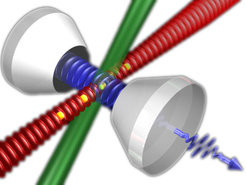Quantum Information Processing
Introduction

In the Quantum Information Processing team, we investigate the implementation of quantum information protocols with single, neutral atoms and photons in optical cavities. Recently, we have implemented quantum gates between atoms and photons, using the state-dependent phase shift upon reflection of a photon from the cavity. We have demonstrated an atom-photon gate, a photon-photon gate, and the nondestructive detection of photons with this mechanism.
These results are one example for the capabilities our systems offer to study and exploit interactions of light and matter in the quantum regime. While photons are excellent carriers of quantum states for large distance transmission, the long coherence times of trapped ultracold atoms are optimal for the storage of quantum information. The strong coupling achievable in our cavity quantum electrodynamics (cavity QED) systems make them ideally suited for the implementation of deterministic quantum interfaces.
Our setups allow for full control over an atom residing inside a cavity as well as overall optical fields to which the atom is exposed. With these tools for quantum engineering at hand, we develop universal light-matter quantum interfaces that efficiently couple single photons to single atoms. We routinely produce streams of single photons, whose shape, frequency, direction, polarization, and phase can independently be controlled. The cavity not only serves as an integral part of the photon creation process but also allows for the efficient and in principle deterministic emission into a well-defined spatial mode. A time reversal of the photon-creation process yields a single-atom quantum memory for photonic polarization qubits.
We also investigate the possibilities to extend our systems to multiple single atoms in one cavity. We are able to reliably load two single atoms into our cavity and determine their phase relation with which they couple to an external laser field and the cavity mode. This will allow us to implement quantum information protocols with multiple atoms.
For future experiments, we also develop fiber-based Fabry–Perot cavities that feature small mode volumes and small physical sides and therefore allow new geometries with multiple cavities. We recently used this new generation of cavities in order to build an experimental setup where a single atom couples simultaneously to two crossed optical cavities. This setup will open the way to study novel quantum information schemes based on two-mode cavity QED.
Atom-cavity systems are naturally at the heart of intriguing concepts for quantum computing and quantum communication. Along these lines, we realized an elementary quantum network comprised of two nodes. In this context, we investigated the building blocks of distributed quantum networks, such as quantum state transfer and remote entanglement generation.
Research Topics
- Quantum gates between atoms and photons
- Quantum networks
- Quantum memories
- Next-generation cavity QED systems
- Beyond single atom cavity QED
- Quantum control of single atoms inside a cavity
- Earlier experiments on light-matter quantum interfaces
Open Position
If you are interested in joining our team as a PhD student, have a look at the job description.
